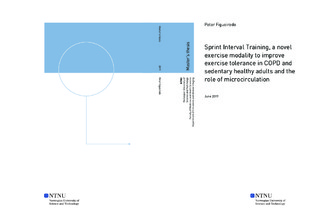| dc.description.abstract | Introduction: Chronic obstructive pulmonary disease (COPD) progression places a limitation on exercise capacity through the deterioration of lung function leading to a sedentary lifestyle, comorbidities and limited function. Exercise is undoubtably an integral part of rehabilitation to improve exercise tolerance, increase functional capacity, and decrease long term mortality risk. However, exercise is challenging in this patient population. Sprint interval training (SIT) has been widely studied, proving to be effective in increasing exercise performance, as well as aerobic capacity in individuals with lower baseline capacity. The effectiveness of SIT in COPD patients where skeletal muscle dysfunction is common has yet to be researched. SIT could prove to be time efficient and effective at improving exercise tolerance and/or aerobic capacity while avoiding the most prominent limitation to exercise COPD patients have, decreased lung function. The aim of this study was to study the microcirculation’s role in SIT adaptations in COPD and healthy controls utilizing near infra-red spectroscopy.
Methods: 9 COPD patients and 8 healthy control subjects completed 3 weeks of SIT training. Training consisted of a 5min warm up, 4x:20s sprints, with 3-5mins of active recovery between sprints, 3xwk. HbO2 slope from linear regression analysis on the first 15s after time to exhaustion (TTE) test was used to quantify microcirculation’s ability to recover muscle tissue O2 desaturation.
Results: Both COPD and healthy groups significantly improved TTE [3:47 ±3:59min (49%) (p=0.046), 5:42 ±4:28min (70%) (p=0.009)] respectively. COPD subjects did not improve VO2peak while the healthy control tended to increase (p=0.089). No changes in HbO2 recovery were found in the COPD group and healthy group [0.004 ±0.014 µM/s (p=0.44), -0.003 ±0.006 µM/s (p=0.28)] respectively.
Conclusion: Sprint interval training has proven to be effective at improving TTE, a common measure used to judge the efficacy of pulmonary rehabilitation on exercise tolerance. Improvements in microcirculation function were not detected. Regardless, just 12 minutes of supramaximal exercise divided into 36 sprints over 3 weeks could be a useful “kickstart” to pulmonary rehab, allowing subsequent training to be at a higher relative intensity which is more effective and time efficient at improving VO2peak and functional capacity. | |
